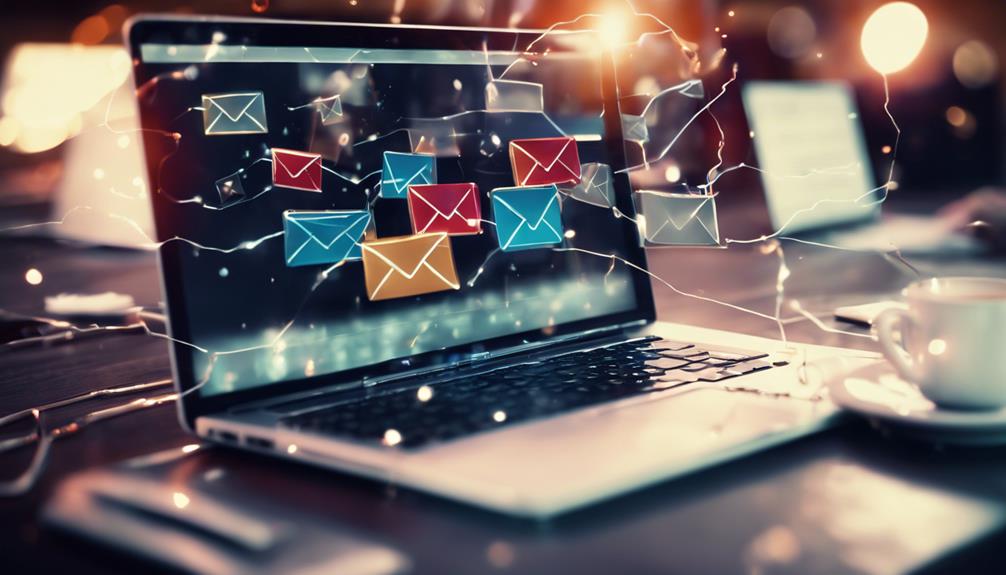Email Marketing Campaigns for B2B Lead Generation
As a B2B marketer, you're likely no stranger to the importance of email marketing campaigns in driving lead generation. But are you getting the most out of your efforts? Understanding your target audience's unique needs and preferences is vital in crafting compelling content that resonates with them. But what does that really mean in practice? How do you build targeted campaigns that speak directly to your audience and drive real results? The answer lies in a combination of strategy, creativity, and data-driven decision making. But where do you start?
Key Takeaways
- Identify target audience by recognizing unique needs, preferences, and behaviors that drive purchasing decisions.
- Craft compelling email content by leveraging data-driven insights into target audience's needs and preferences.
- Build effective email campaigns by planning and executing targeted segments, considering factors like email frequency and campaign segmentation.
- Measure and optimize performance by tracking key performance indicators (KPIs) and analyzing metrics to determine areas for improvement.
Understanding Your Target Audience
To craft effective email marketing campaigns, you must first identify and understand your target audience, recognizing their unique needs, preferences, and behaviors that drive their purchasing decisions. This involves creating buyer personas, which are detailed profiles of your ideal customers.
By analyzing demographic, firmographic, and behavioral data, you can develop personas that capture the essence of your target audience.
Audience segmentation is another vital step in understanding your target audience. This involves dividing your email list into distinct groups based on specific characteristics, such as job function, industry, or company size.
By segmenting your audience, you can tailor your email campaigns to resonate with each group, increasing the likelihood of conversion.
To develop effective buyer personas and audience segments, you'll need to analyze data from various sources, including customer surveys, social media, and marketing automation platforms.
This data-driven approach will enable you to create targeted email campaigns that speak directly to the needs and interests of your audience, driving engagement and conversion.
Crafting Compelling Email Content
By leveraging data-driven insights into your target audience's needs and preferences, you can craft compelling email content that resonates with each segment and drives meaningful engagement.
This involves analyzing your audience's pain points, interests, and behaviors to create content that speaks directly to them.
Start by optimizing your subject lines, which should be clear, concise, and attention-grabbing. Use A/B testing to determine which subject lines perform best with different segments of your audience.
When it comes to the body of your email, focus on visual storytelling to convey complex information in a digestible and engaging way.
Use a mix of images, videos, and infographics to break up text and illustrate key points. Make sure your content is scannable, with clear headings and concise paragraphs that allow readers to quickly grasp the main message.
Use data and statistics to support your claims and demonstrate the value of your product or service.
By taking a strategic and data-driven approach to crafting your email content, you can increase engagement, build trust, and ultimately drive conversions.
Building Effective Email Campaigns
With a solid foundation of compelling email content in place, you're now ready to build effective email campaigns that drive real results and align with your overall marketing strategy.
To achieve this, you need to carefully plan and execute your email campaigns, considering factors such as Email Frequency and Campaign Segmentation.
Email Frequency is vital in maintaining subscriber engagement. You need to strike the right balance between keeping your audience informed and avoiding overwhelming them with too many emails.
Analyze your email metrics to determine the ideal frequency for your campaigns. For example, if you notice a significant drop in open rates after a certain number of emails, it may be time to reassess your frequency.
Campaign Segmentation is another key aspect of building effective email campaigns. By dividing your email list into targeted segments based on demographics, behavior, or preferences, you can create highly relevant and personalized content that resonates with each group.
This approach not only boosts engagement but also increases the likelihood of conversion. By incorporating these strategies into your email campaigns, you'll be well on your way to driving real results and achieving your B2B lead generation goals.
Measuring and Optimizing Performance
As you launch your email campaigns, it's crucial that you're tracking key performance indicators (KPIs) to gauge their effectiveness and identify areas for improvement.
This involves monitoring performance metrics such as open rates, click-through rates, conversion rates, and unsubscribe rates.
By analyzing these metrics, you can determine which campaigns are driving the most value and which need optimization.
To take your email marketing campaigns to the next level, consider the following strategies:
Track and analyze performance metrics: Use data to inform your decision-making and identify trends in your email campaigns.
Conduct A/B testing: Test different subject lines, email copy, and calls-to-action to determine which variations perform best.
Use segmentation and personalization: Segment your email list and personalize your content to improve engagement and conversion rates.
Nurturing Leads Through Automation
Implementing automated email workflows can substantially enhance your lead nurturing efforts, allowing you to target specific segments of your audience with tailored content at every stage of the buyer's journey.
By automating your email campaigns, you can guarantee that leads receive relevant information at the right time, increasing the likelihood of conversion.
Lead scoring is a vital component of this process, as it enables you to track a lead's engagement and behavior, and trigger targeted emails accordingly.
Drip campaigns are another effective way to nurture leads through automation.
By creating a series of pre-set emails that are triggered by specific actions or milestones, you can educate and engage leads without manual intervention.
For example, you can set up a drip campaign that sends a series of emails to new subscribers, providing them with valuable content and insights about your product or service.
By automating these processes, you can free up time and resources to focus on higher-level strategies, while still delivering personalized and relevant content to your leads.
This not only enhances the customer experience but also improves the efficiency and effectiveness of your lead nurturing efforts.
Frequently Asked Questions
Can I Use Personal Email Accounts for B2B Email Marketing Campaigns?
"When using personal email accounts, you're risking sender reputation and violating email etiquette best practices, as it's hard to scale and maintain professionalism. This can lead to poor delivery rates, damaging your brand's credibility."
How Often Should I Clean and Update My Email List?
You should regularly clean and update your email list to maintain data hygiene and prevent decay. Segment your list quarterly to guarantee accuracy and relevance, removing inactive or unengaged subscribers to optimize performance.
Are There Specific Email Marketing Laws for B2B Companies?
You must navigate data compliance and industry regulations, such as GDPR and CCPA, which impact B2B companies. Familiarize yourself with these laws to guarantee your email marketing practices align with global standards and avoid costly penalties.
Can I Use Email Marketing Automation for Small Lists?
You can leverage email marketing automation even with small lists by focusing on small batches and targeted segments. This approach allows for more personalized and relevant messaging, increasing engagement and conversion rates substantially.
How Do I Handle Email Marketing Campaign Failures?
When a campaign tanks, you're not just dealing with a failed email blast – you're facing a potential loss of trust and revenue. Conduct a campaign autopsy, analyzing metrics to pinpoint failure triggers, and use those insights to inform future strategy.
Conclusion
By incorporating these strategies, you'll create personalized and relevant email campaigns that resonate with your target audience, driving lead generation and revenue growth.
To maximize ROI, continually measure and optimize performance through key metrics and A/B testing.
By doing so, you'll refine your approach, improve engagement, and convert more leads.
Effective email marketing campaigns are vital for B2B lead generation – make data-driven decisions to elevate your strategy and achieve tangible results.







